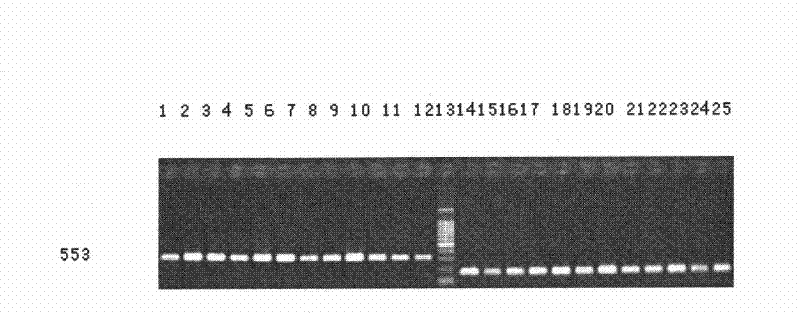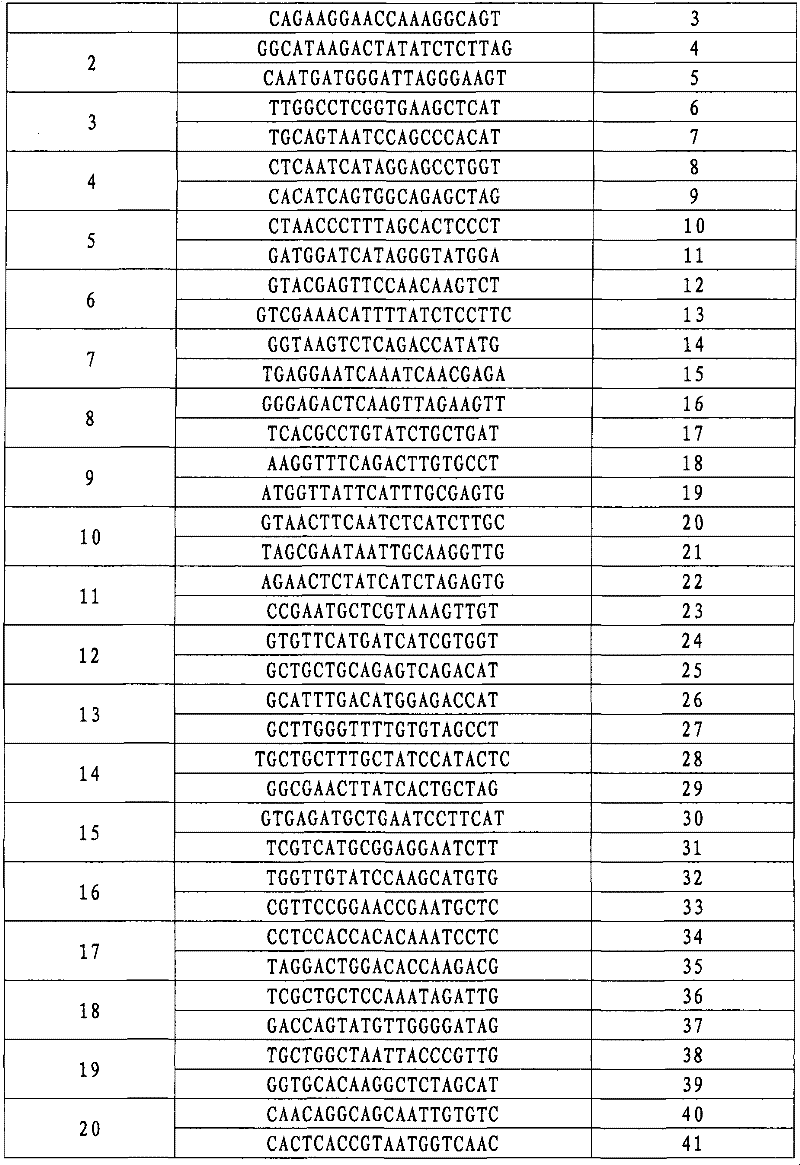Molecular marker SIsv1223 closely linked with millet herbicide-resistant gene
A herbicide-resistant gene and molecular marker technology, applied in the field of molecular biology, can solve the problems of lack of herbicide resistance, obstacles to millet production, and inability to apply broad-spectrum herbicides in corn fields, and achieve high-throughput application effects
- Summary
- Abstract
- Description
- Claims
- Application Information
AI Technical Summary
Problems solved by technology
Method used
Image
Examples
Embodiment 1
[0043] Example 1: Construction of millet F2 generation segregation population
[0044] The male parent is Zhanggu No. 1: Anti-Nabujing type (high plant type, plant height is about 150cm), long and narrow flag leaves, red bristles, red glumes, fertile, greenish leaf color.
[0045] The female parent is the A2 sterile line: non-resistant Nabujing type (short plant type, plant height about 100cm), short and wide flag leaves, green bristles, green glumes, partly sterile, yellowish leaf color.
[0046] F1 (Zhang Zagu No. 3, partially anti-Nabu net type, plant height of about 130cm) was obtained by crossing the male parent and the female parent.
[0047] The F1 generation was self-crossed to generate the F2 generation population, and a total of 480 individual plants were obtained. 480 individuals of the F2 generation were analyzed according to the method for determining the type of anti-Natura, and a total of 360 strains were found to be anti-Natten and partly anti-Nart (includin...
Embodiment 2
[0048] Example 2: Extraction of parental and F1 generation, F2 generation individual genomic DNA
[0049] Genomic DNA of the parents, the F1 generation, and 480 F2 generation individuals in Example 1 were extracted by the CTAB method, and the specific methods were as follows:
[0050] (1) Weigh 1.0g of fresh leaves, cut them into pieces and put them in a mortar, grind them with liquid nitrogen, add 3ml of 1.5×CTAB, grind them into a homogenate and transfer them to a 15ml centrifuge tube, then add 1ml of 1.5× CTAB into the mortar Rinse with CTAB and transfer to a centrifuge tube. After mixing, place in a water bath at 65°C for 30 minutes, and shake slowly from time to time.
[0051] Among them, the formula of 1.5×CTAB is as follows (1L):
[0052] CTAB 15g
[0053] 1M Tris.Cl (pH 8.0) 75ml
[0054] 0.5M EDTA 30ml
[0055] NaCl 61.4g
[0056] Add deionized water to make up to 1 L, and add mercaptoethanol with a final concentration of 0.2% (2 ml) before use.
[0057] (2) ...
Embodiment 3
[0062] Example 3: Preparation of Molecular Markers
[0063] Taking the Genomic DNA of the anti-Narth net type or part of the anti-Natur net type in the male parent, F1 generation, or F2 generation extracted in Example 2 as a template, with molecular marker primers (SEQ ID NO: 2 and SEQ ID NO: 3 ) for PCR amplification.
[0064] The PCR reaction system is as follows:
[0065] Sterile water 20.2μl
[0066] 10*Buffer (with Mg 2+ ) 2.5 μl
[0067] dNTPs (25mM) 0.15μl
[0068] Taq enzyme (5U / μl) 0.15μl
[0069] Forward primer 0.5μl
[0070] Reverse primer 0.5μl
[0071] Template 1.0μl
[0072] Total volume 25μl
[0073] The PCR reaction procedure is as follows:
[0074] Pre-denaturation at 94°C for 5 minutes; denaturation at 94°C for 30 seconds, annealing at 60°C for 30 seconds, extension at 72°C for 40 seconds, and 35 cycles; final extension at 72°C for 3 minutes. PCR amplification products can be stored at 4°C.
[0075] The amplified product is purified to obtain mo...
PUM
 Login to View More
Login to View More Abstract
Description
Claims
Application Information
 Login to View More
Login to View More - R&D
- Intellectual Property
- Life Sciences
- Materials
- Tech Scout
- Unparalleled Data Quality
- Higher Quality Content
- 60% Fewer Hallucinations
Browse by: Latest US Patents, China's latest patents, Technical Efficacy Thesaurus, Application Domain, Technology Topic, Popular Technical Reports.
© 2025 PatSnap. All rights reserved.Legal|Privacy policy|Modern Slavery Act Transparency Statement|Sitemap|About US| Contact US: help@patsnap.com



